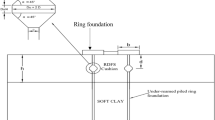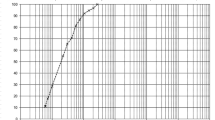Abstract
Expansive soils can cause significant distress in pavement construction because of their swelling and shrinking nature. One such method to control this problem is addition of stabilising agent to the expansive soil. Millions of tonnes of quarry dust waste produced every year are not disposed properly, resulting in environmental pollution as well as serious health hazards. Hence, an experimental study including scanning electron microscope (SEM) analysis was taken up for possible replacement of quarry dust in the expansive clay solving a dual problem. The quarry dust percentage in expansive clay was varied from 10 to 25%. The laboratory tests were conducted to ascertain the index properties, compaction and swelling characteristics and cohesion properties of expansive clay–quarry dust mixes. The unconfined compressive strength as well as the maximum dry density increases up to 85% soil + 15% quarry dust proportion. Hence, the optimum dosage of the quarry dust is found to be 15%. The swell potential decreases from 14.73 to 7.17% at the optimum dosage. The performance evaluation for the use of quarry dust waste in subgrade stabilisation based on group index (GI) method has been discussed in this paper. From the cost analysis, it has been confirmed that there is a substantial savings in the cost of flexible pavement construction when the quarry dust stabilised expansive clay is used as a subgrade in place of expansive clay.











Similar content being viewed by others
References
Abd El-Aziz MA, Abo-Hashema MA (2013) Measured effects on engineering properties of clayey sub grade using lime-homra stabilizer. Int J Pavement Eng 14(4):321–332
Aditya C, Yadav RK (2016) Effect of quarry dust on engineering properties of black cotton soil. Int J Innov Res SciTechnol 2(11):715–718
Akanbi DO, Job FO (2014) Suitability of black cotton (clay) soil stabilized with cement and quarry dust for road bases and foundations. Eng J GeotechEng 19:6305–6313
Asokan P, Saxena M, Asolekar SR (2007) Solid wastes generation in India and their recycling potential in building materials. Build Environ 42(6):2311–2320
Cokca E (2001) Use of class c fly ash for the stabilisation of an expansive clay. J Geotech Geo environ Eng 127(7):568–573
Dang LC, Khabbaz H (2018) Experimental investigation on the compaction and compressible properties of expansive clay reinforced with bagasse fibre and lime. In: Proceedings of the 2ndGeoMEast international congress and exhibition on sustainable civil infrastructures: innovative infrastructure geotechnology, pp 64–78
Deepiya R, Durga N, Steffi J, Ayappan S (2014) Stabilisation of clay soil using quarry dust and lime. Int J AdvInfSciTechnol 32:111–114
Desai ID, Oza BN (1997) Influence of anhydrous calcium chloride on shear strength of clays. SympExpans clays 1:17–25
Gopal R, Rao ASR (2007) Basic and applied soil mechanics. New age international, New Delhi
Havangi VG, Prasad PS, Guruvittal UK, Mathur S (2006) Feasibility of utilization of copper slag–fly ash–soil mixes for road construction. Highw Res Bull No 75:59–75
Holtz Robert D, Kovacs WD, Sheehan TC (1981) An introduction to geotechnical engineering, vol 733. Prentice-Hall, New York, Englewood Cliffs, NJ
Indian Standard (IS) Code 2720 (Part 40)–1977. Determination of free swell index for soils
Indian Standard (IS) Code 2720 (Part 4)–1985. Determination of water content-dry density relation using light compaction (second revision)
Indian Standard (IS) Code 2720 (Part 41)–1977. Measurement of swelling pressure of soils
Indian Standard (IS) Code 2720 (Part 10)–1981. Determination of unconfined compressive strength (second revision)
Indian Standard (IS) Code 2720 (Part 5)–1985. Determination of liquid limit and plastic limit (second revision)
Indian Standard (IS) Code 2720 (Part 7)–1980. Grain size analysis (second revision)
Jones LD, Jefferson Burland J (2012) Expansive clays. ICE manual of geotechnical engineering. Vol 1, geotechnical engineering principles problematic soils and site investigation. ICE Publishing, London, pp 413–441
Khanna SK, Justo CEG (2001) Highway engineering. Nem Chand Publication, Roorkee, India
Kharade AS, Suryavanshi VV, Gujar BS, Rohankit DR (2014) Waste product ‘quarry dust’ from sugar industry can be used as stabilizing material for expansive clays. Int J Res EngTechnol 3(3):506–512
Kumar BSG, Sumedha RS, Pradeep U, Kumar KG, Reddy PP (2015) Sub grade strengthening of roads on black cotton soil using quarry dust. Int J Res EngTechnol 4(6):456–458
Little Dallas N (1998) Evaluation of structural properties of lime stabilized soils and aggregates. National lime association, Virginia
Madhavan P, Sanjay Raj (2005) Budhpura ‘ground zero’ sandstone quarrying in India. Committee of the Netherlands, Netherlands, p. 32
Meshida EA, Oyekan GL, Ogundalu AO (2013) Effects of steel mill dust on the strength characteristics of black cotton clay soils. Int J SciEng Res 4(5):2242–2246
Mir BA (2015) Some studies on the effect of fly ash and lime on physical and mechanical properties of expansive clay. Int j CivEng 3(3 & 4B) 13(3):203–212
MoRTH (Ministry of Road Transport and Highways) (2013) Specifications for road and bridge works. In Indian roads congress, New Delhi, India
Naman A (2015) Effect of stone dust on some geotechnical properties of soil. IOSR J MechCivEng 12(1):61–64
Osinubi KJ, Jambiya TS, Nmadu I (2009) Lime stabilisation of black cotton soil using bagasse ash as admixture. Adv Mater Res 62:3–10
Paul A, Anumol VS, Moideen F, Jose JK, Abraham A (2014) Studies on improvement of clayey soil using egg shell powder and quarry dust. Int J Eng Res Appl 19:55–63
Peethamparan S, Olek J (2008) Study of the effectiveness of cement kiln dusts in stabilizing Na-Montmorillonite clay. J Mater CivEng 20(2):137–146
Petry TM, Little DN (2002) Review of stabilisation of clays and expansive clays in pavements and lightly loaded structures—history, practice, and future. J Mater CivEng 14(6):447–460
RajgorMamta B, Pitroda J (2013) A study of utilization aspect of stone waste in Indian context. Glob Res Anal 2(1):50–53
Ramaji AE (2012) A review on the soil stabilisation using low-cost methods. J ApplSci Res 8(4):2193–2196
Sabat AK (2012) Utilization of bagasse ash and lime sludge for construction of flexible pavement in expansive clay areas. Electron J GeotechEng 17:1037–1046
Sabat AK (2012b) Stabilisation of expansive clay using waste ceramic dust. Electron J GeotechEng 17:3915–3926
Sabat AK, Bose B (2013) Improvement in geotechnical properties of an expansive clay using fly ash-quarry dust mixes. EJGE 18:3487–3500
Sabat AK, Nanda RP (2011) Effect of marble dust on strength and durability of rice husk ash stabilized expansive clay. Int J CivStructEng 1(4):939–948
Safiuddin M, West JS, Soudki KA (2010) Hardened properties of self-consolidating high-performance concrete including rice husk ash. CemConcr Compos 32(9):1–38
Sairanen M, Rinne M, Selonen O (2018) A review of dust emission dispersions in rock aggregate and natural stone quarries. Int J Min Reclam Environ 32(3):196–220
Sandeep K (2017) The effect of urbanisation on environment in India. Int J EmergTechnol 8(1):122–126
SarvadePurushotham G, Nayak S (2014) Studies on the utilization of quarry dust to improve the geotechnical properties of lithomargic clay. Int J AdvStructGeotechEng 3(1):54–59
NHAI (National Highway Authority of India) (2020) Schedule of rates (SoR). Ministry of Road and Transport, Government of India
Sharma RS (2003) Influence of wetting- drying cycle on subsequent loading behaviour of an unsaturated expansive clay. In: the 12th Pan-American conference on soil mechanics and geotechnical engineering and 39th U.S. rock mechanics symposium., Massachusetts Institute of Technology, Cambridge, Mass pp 557–562
Specifications of AASHTO (2010). Standard specification for transportation materials and methods of sampling and testing. American Association of State Highway and Transportation Officials
Sridharan A, Soosan TG, Jose BT, Abraham BM (2006) Shear strength studies on soil-quarry dust mixtures. GeotechGeolEng 24(5):1163–1179
Uttara S, Bhuvandas N, Aggarwal V (2012) Impacts of urbanisation on environment. Int J Res EngApplSci 2(2):1637–1645
Venkateswarlu H, Prasad DSV, Prasada Raju GVR (2015) Study on geotechnical properties of stabilized expansive Clay-quarry dust mixes. IOSR J MechCivEng 12(6):104–110
Verma SK, Maru S (2013) Behavioural study of expansive clays and its effect on structures–a review. Int J InnovEngTechnol 2(2):228–238
Wheeler SJ, Sharma RS, Bussien MSR (2003) Coupling hydraulic hysteresis and stress strain behaviour in unsaturated soils. Geotech 53(1):41–54
Young JF, Bentur A, Mindess S (1998) The science and technology of civil engineering materials. Pearson, London
Author information
Authors and Affiliations
Corresponding author
Supplementary Information
Below is the link to the electronic supplementary material.
Rights and permissions
About this article
Cite this article
Sudhakar, S., Duraisekaran, E., Dilli Vignesh, G. et al. Performance Evaluation of Quarry Dust Treated Expansive Clay for Road Foundations. Iran J Sci Technol Trans Civ Eng 45, 2637–2649 (2021). https://doi.org/10.1007/s40996-021-00645-4
Received:
Accepted:
Published:
Issue Date:
DOI: https://doi.org/10.1007/s40996-021-00645-4




